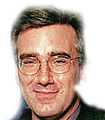
Keith Olbermann
Memories of 9/11
http://www.NewsAndOpinion.com | On the rainy afternoon of Friday, Sept., 14, 2001, a voice more weary than shocked scratched across a police radio, blaring onto Canal Street: "Body parts found on the 14th floor of the World Financial Center." With the efficiency and dispassion of a bank teller, a woman dispatcher repeated the grim news: "Body parts found on the 14th floor of the World Financial Center."
Already that day, the grisliness of those discoveries had given way to numbness. In fact, the awful concept — "body parts" — seemed like a small blessing. There would be identifications, and funerals, and memorials and graves — and closure.
Within days, 5,300 human remains had been found, but not identified. The Medical Examiner's Office predicted that within two to three weeks, an extensive DNA matching program would begin to get results.
The results came. And the funerals.
DNA testing identified well more than half of the victims — men, woman and children who would number more than 2,800. But the number of body parts would be nearly 20,000. The Medical Examiner's Office continued to struggle to put names and lives to the smallest of remains.
Of all the dead, the number of victims who could be identified simply by sight had been only 12. The medical examiner's office had identified 1,500 more.
Then, like so many of the families have had to do, the examiners had to face reality. The number of identifications began to drop. Fourteen last January. Nine in July. Four in August. The science isn't there — not yet — to identify the 60 percent left.
And thus comes another agonizing choice for the families of those who have nothing to bury. Proceed onward, or wait for a day that may never come, when DNA testing can do still more, with less.
The family of New York City firefighter Michael Ragusa was lucky. His remains were not identified, but last November, his parents were reminded that he had volunteered as a bone marrow donor. He had given blood. There would be something of Michael Ragusa to bury. His family's closure came Monday. Ragusa became the last of New York's 343 lost firefighters to be memorialized.
And what of the others?
The medical examiner's office thinks new ways of DNA matching could identify as many as 200 more victims in the next year. But that still leaves about 1,100 people unidentified, 1,100 people for whom life ended too quickly and for whose families closure will come too slowly.
The solution, like so many in the past two years, is simple and somber. The unidentified remains will be interred, carefully preserved and housed, in hopes that some day they will be identified.
They will be kept below the memorial that will rise to all the dead of The World Trade Center.
Their resting places will have no gravestones. But we will remember, nonetheless, that they are there.
Would that we still had the even more tangible reminders that appeared as early as the night of the attacks: the homemade posters of the "missing" from The Trade Center. As they covered seemingly every available space in the city, they defined desperation: A plea from the family of each depicted; a collective, communal act of desperate hope that the missing were merely that — missing. Injured, hospitalized, unconscious. Victims of amnesia. Or even trapped in the rubble.
Anything that was better than the unspeakable horror.
As days passed, hope should have ebbed but instead it grew. Not only were new posters of the missing still going up across the city, but good Samaritans began papering the town with pictures of people they did not personally know. The posters resonated in an almost unspeakable way. It was the rare and fortunate New Yorker who is not halted in the streets by one of them.
The resonance, perhaps, was in the smiles shown on nearly every photograph on nearly every poster.
Amid the unutterable grief, the people in the posters did not stare out at us in pain, or fear or sadness. They smiled.
And then, four days after the attacks, their smiles were answered with callousness, and with controversy. Suburban railroad executives ordered the posters removed from the walls at Grand Central Station, for what they called "aesthetic reasons."
"What is this," a policeman asked me, "the Louvre?"
That policeman was, in a way, prescient.
Days after the news came that the missing posters had been ordered pulled down by the management at Grand Central, the station's staff turned part of it into a kind of Louvre, a virtual museum of the missing. Just off the main room of that station, commuters could be seen, literally stopped in their tracks, in front of a 12-paneled screen, placed there by the railroad's employees. There were perhaps 300 posters there, four of them depicting John Thomas Andreacchio. On each of them, next to the smile peeking out from under Andreacchio's mustache, had been hand-written the word "found."
In the months to come, as the scene at Ground Zero became less and less dramatic, as the smoke trailed away and the debris vanished, this unassuming shrine at Grand Central gradually became as moving a tribute to the 3,000 lost as any in the city.
And then, early this year, just after the holidays, it vanished.
Officials at the city's transit museum say the memorial of posters was given to them. The transit museum says it is not currently on display, but may be later, after that museum's remodeling is completed next week.
In October 2001, the Metropolitan Museum of Art and the Museum of the City of New York held a public forum to discuss if it was appropriate to preserve the posters, if it was permissible for anybody, besides family members, to actually remove them and make them a part of a solemn remembrance of that time.
It was a controversial question. To remove the posters was to acknowledge that the smiles they depicted belonged not to the missing, but the dead.
The City Museum says it did indeed collect many of the posters. Just like the transit museum, it may display them. But not now. Perhaps later.
And so this simplest, least planned, most organic of memorials is now, itself, just a memory.
Enjoy this writer's work? Why not sign-up for the daily JWR update. It's free. Just click here.
The writer hosts MSNBC's “Countdown with Keith
Olbermann.” The news program, dedicated to all
of the day’s top stories, telecasts weeknights, 8-9
p.m. ET. Comment by clicking here.
09/09/03: As the Western World churns
08/25/03: As the Western World churns
07/30/03: Nike, lawyer, almost canceling on Kobe?
06/20/03: The parenting files
06/19/03: As the world churns
06/13/03: The No. 1 story is No. 2: The poop on America and its bathrooms
06/04/03: Terror attack preparation: Too much or too little?
06/02/03: Bush vs. Clinton?
05/29/03: Ticket blitz in New York City? Hey, at least pregnant women won't be blocking stairwells
05/21/03: ‘Barney’ as torture
05/08/03: Because you just can't take the news too seriously
04/30/03: Should we be more scared of SCARS, or a government that will readily deny you your freedom on the suspicion that you may have it?
04/29/03: Man bites dog --- really!
04/28/03: Because you just can't take the news too seriously ...
04/25/03: The panic over SARS
04/22/03: Playing —and greeting cards in a changed world
04/21/03: Reading your own obituary ... and other 'oops' moments
04/15/03: Saddam Hussein and the Sorcerer's Stone: The secret to Saddam's immortality

